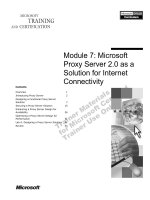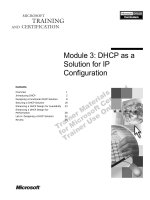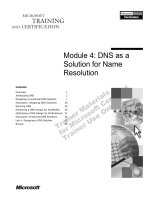Exercise as a medicine for cardiovasular protection
Bạn đang xem bản rút gọn của tài liệu. Xem và tải ngay bản đầy đủ của tài liệu tại đây (1.73 MB, 35 trang )
Exercise as a Medicine for
Cardiovasular Protection
Thomas G. Allison, PhD, MPH, FACC
Mayo Clinic, Rochester, MN
©2012 MFMER | slide-1
VNHA – Da Nang
October, 2014
No Disclosures
Question 1: Does Exercise Prevent CVD
over a Lifetime in Healthy People?
→
This is principally an epidemiologic question
Large, long-term randomized trials are not feasible Expert Opinion: CHD Prevention
• US Surgeon General 1996
• Significant health benefits (primarily
cardiovascular) from moderate amounts of
daily physical activity
• 30 minutes brisk walking or raking leaves,
• 15 minutes running
• 45 minutes sports
• More exercise is better
• How many of you follow this recommendation?
Question 2: Does exercise reduce clinical
events and increase quality adjusted life
years in patients with CVD and diabetes?
©2012 MFMER | slide-7
versus
Versus
Stress test 1
Stress test 2
Effect of Exercise on Coronary Artery
Disease Progression
©2012 MFMER | slide-8
Schuler et al. doi:10.1093/eurheartj/eht111; April 7, 2013
DPP Results
11.0%
7.8%
4.8%
0%
2%
4%
6%
8%
10%
12%
Annual Incidence of Type 2
Diabetes
Placebo Metformin Diet/exercise
Knowler, WC et al, NEJM 2002;364:393-403
LOOK AHEAD Research Group N Engl J Med 2013;369:145-54.
LOOK AHEAD TRIAL: Primary Composite Outcome
LOOK AHEAD Research Group N Engl J Med 2013;369:145-54.
• 27 patients with stable, post-infarction systolic HF
• Randomized
1) Moderate continuous training (MCT)
2) Aerobic interval training (AIT)
3) Control
• 3 x week for 12 weeks
• No deaths or untoward events
Wisloff Circulation 2007;115:3086
Exercise Training in Heart Failure
Surrogate Endpoints: Favorable Remodeling
Results
Wisloff Circulation 2007;115:3086
O’Connor CM et al. JAMA 2009;301:1439-1450
Exercise Training in CHF: Mortality
and Morbidity Effects
HF-ACTION Results
• Suboptimal adherence to exercise training
• 40% of exercisers reported <1.5 h of
exercise/week
• Smaller training effect than in other smaller
studies
O’Connor CM et al. JAMA 2009;301:1439-1450
©2012 MFMER | slide-16
Exercise is great medicine, but sometimes
it can be a hard pill to swallow.
Explains negative results in LOOK AHEAD and HF-ACTION
Conclusions
• Exercise appears to be potentially good
medicine for CV prevention
• Strong epidemiological evidence for primary
prevention of CAD and diabetes
• Beneficial effects on risk factors
• Clinical trials for secondary prevention are limited in
number, size, and methodology
• Inadequate stimulus and poor compliance with
exercise programs likely limits benefit
• Supervised programs seem to superior to home
programs
• No evidence of harm despite exercise paradox
©2012 MFMER | slide-17
Living Under the
Umbrella of Good
Cardiovascular
Health
FBG
< 5.6
LDL-C
< 2.6
SBP
< 120
FBG
> 6.9
LDL-C
> 3.4
SBP
> 140
Start treatment ←
Ideal levels =
Contact:
Physician
Patient
19
• Comments?
• Questions?
• Contact:
Benefits of Physical Activity on
Coronary Risk Factors
• Improved blood lipids
HDL-cholesterol
Triglycerides
Small, dense LDL-cholesterol
• Decreased blood pressure
~ 4/4 mmHg in normotensive subjects
~ 11/6 mmHg in hypertensive subjects
• Improved insulin resistance
• Reduced visceral adiposity
• Reduced hs-CRP
Effect of Exercise on Coronary Artery
Disease Progression
©2012 MFMER | slide-22
Schuler G et al. Circulation 1992:86:1-11
T
T
T
C
C
C
• 113 patients with stable angina randomized
• 12 month training program versus usual care
Meta-Analysis: Exercise for 2° CHD
Prevention
• 8440 CHD patients randomized to exercise-based
rehab programs
• 27% reduction in all-cause mortality
• 31% reduction in CHD mortality
• No evidence of reduction in non-fatal CHD
Jolliffe et al, The Cochrane Library 2003:Issue 4
Effect of Aggressive Lifestyle Management
on Symptom Burden and Severity in
Patients with Atrial Fibrillation
• 150 patients with history of atrial fibrillation but
currently in sinus rhythm
• Randomized to aggressive lifestyle
management versus usual care + fish oil 3g/day
• Lifestyle management program
• Phase 1: low calorie diet + light exercise program for
8 weeks
• Phase 2: low glycemic diet + vigorous exercise
program
• Patients kept diet and activity diary
©2012 MFMER | slide-24
Abed H et al. JAMA 2013;310:2050-2060
Results
• Low completion rates
• 42/75 (56%) in intervention; 39/75 (52%) in control
©2012 MFMER | slide-25
Abed H et al. JAMA 2013;310:2050-2060









